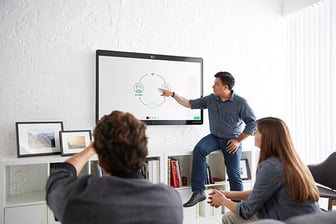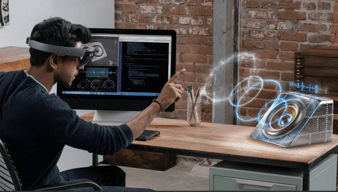What we saw at HECC 2017!
November 21, 2017 •Network Solutions

What the HECC is going on in the K-12 industry? NSI hit the road last week to attend the Hoosier Education Coordinators Conference (HECC) in Indianapolis and are excited for what is on the horizon for educators! This year at HECC we saw a larger emphasis on IoT devices and how they are able to change the education vertical in an interesting way.
Less Physical Attendance vs Increase in Attendance

One of the most exciting advancements is the ability to actually get a student in a room with a teacher. The traditional way of educating has been to hope and pray that the students are able to make it to class. Yes, there are great programs like kids club and other before/after school programs to help them get to school. But what are we supposed to do when it’s just simply not possible?
Finally collaboration tools are reaching a technological apex, making it possible to do more. I mentioned in my article “Are you ready for HECC 2017?” the Sparkboard by Cisco. We attended talks that Cisco put on to learn more and this tool isn't just a pretty screen.This platform is about the experience and making it easy for any end-user to operate. Students in 3rd grade should be able to use this as easy as an educator.
Spark allows students in-class to collaborate on an high definition whiteboard! What do you do for students who missed class? These sessions are able to be recorded for students to view later, absent students are able to attend LIVE from a smartphone, and those who attend are even able to edit in REAL-TIME. This is some pretty awesome stuff and it’s even good for the school budget! How?
Indiana public schools have the ability to receive general fund money. This money is awarded based on many factors but a major one is reaching a set minimum hours of teaching to students. Schools don’t have the ability to make sure every student makes it to class everyday but they have the ability to change when and where a student can be taught. Spark licensing and Sparkboards can become cost-neutral by giving students a quality teaching environment and reaching the minimum hours.
Think about this example. A school like East Chicago gets around $8,100/student per year. If they can increase their student count by just 10 students a year that is $81,000 of additional revenue. $81,000 means 5 years of spark licensing for every teacher, administrator, and student in the district as well as 4 70in Spark Boards. And that is $81,000 they could potentially put towards more spark boards for the next 5 years.
Students are able to attend class and have meaningful engagements from their smartphone and having the ability to put these students in a “seat”, even if it’s just digital, helps schools secure the attendance needed to hit necessary benchmarks to receive money from a general fund.
AR & VR
Augmented and virtual reality are tools that may seem just like fun toys that will give educators a five-minute break from the chaos of running a classroom but in

reality they are opening up more doors for educators to make an impact. At HECC we saw VR headsets being used to depict how global warming effects our planet and teaching people about how people lived in the 1600s.
VR gives educators the ability to engage with students on a different level. Instead of popcorn reading around the room about what the pyramids are like, why not take a class trip there? Students seem to be becoming increasingly visual, maybe this is a changing of the times, but a lot of the learning tools were visually stimulating. This gives us a little insight into what the future of education will look like.
Augmented reality transforms the place they are in. Students are able to physically pick up a sword made of Styrofoam but what they see is a sword used in battle by the Romans. The ability to show kids first-hand what they are learning about gives them a deeper understanding of what is going on in their textbook and keeps their attention for much longer than big blocks of text.
Techin’ Teachers
The biggest development we saw at HECC was not any particular technology but more so the way that teachers are going to be educating in the future. Educators and administrators are not bound by the four walls in their classroom but are now bound by those in the IT department. There were hundreds of different devices aimed to capture a portion of the classroom and deciphering the best ones is going to take a magic trick or two.
Devices that allow students to visit the places talked about in their textbooks, collaborate in real-time, and capable of printing 3D models are what our curriculum will be developed around. We are looking at being able to provide an “almost-there” experience for our students. They will have a more kinetic understanding of their studies versus how the rest of us learned – out of books.
Get Updates
Featured Articles
Categories
- AI (18)
- Automated Technology (9)
- backup (1)
- Cisco (29)
- Cisco Live Update (1)
- Cisco News (2)
- Cisco UCS (1)
- Cloud Networking (4)
- Collaboration (26)
- compute (1)
- CyberSecurity (34)
- Data Center (32)
- Defense (1)
- DevOps (3)
- DisasterRecovery (1)
- DNA (2)
- Education (3)
- Encryption (1)
- Enterprise Networking (32)
- Full-Stack (1)
- Future (1)
- healthcare (2)
- hybrid cloud (1)
- Innovative Technology (12)
- Internet of Things (2)
- IoT (2)
- Managed Services (11)
- Manufacturing (1)
- Modern Data Center (2)
- Monitoring (2)
- Network Management (4)
- Networking (2)
- NSI (1)
- nutanix (1)
- Observability (1)
- OT (1)
- Ransomware (2)
- SchoolTechnology (6)
- SD-WAN (1)
- SDN (1)
- securit (1)
- Security (73)
- security management (4)
- security strategy (8)
- SSE (1)
- sustainability (1)
- Telehealth (4)
- Telemedicine (1)
- veeam (1)
- Video (1)
- videoconferencing (1)
- Virtualization (2)
- webex (3)
- XDR (1)
- Zero Trust (8)


